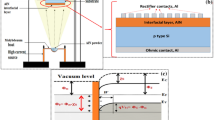Abstract
A series of Alq3 thin films with the thicknesses of 50, 100, and 200 nm was deposited on Si substrates at room temperature using the thermal evaporation method. The thermal crystallization process of Alq3 thin films, especially 50 nm thick films, was successfully examined using high-temperature X-ray diffraction (HT-XRD) with the in-plane scan mode. Film thickness, density, and changes in surface roughness while heating were determined using X-ray reflectometry (XRR). The decreased density and increased surface roughness, which were accompanied by sublimation, indicate the instability of the Alq3 film. Thus, thermal instability is a major factor for device failure.








Similar content being viewed by others
References
Tang CW, VanSlyke SA. Organic electroluminescent diodes. Appl Phys Lett. 1987;51:913–5.
Aziz H, Popovic ZD. Degradation phenomena in small-molecule organic light-emitting devices. Chem Mater. 2004;16:4522–32.
Xu MS, Xu JB. Nanoscale study on origins of the bright clusters in/on moisture-exposed tris(8-hydroxyquinoline) aluminum thin films. Synth Met. 2004;145:177–82.
Xu MS, Xu JB, Lou EZ, Xie Z. Nanoscale investigation on nature of dark hole in moisture-exposed tris(8-hydroxyquinoline) aluminum thin films. Chem Phys Lett. 2003;374:656–60.
Papadimitrakopoulos F, Zhang XM, Thomsen DL III, Higginson KA. A chemical failure mechanism for aluminum(III) 8-hydroxyquinoline light-emitting devices. Chem Mater. 1996;8:1363–5.
Papadimitrakopoulos F, Zhang XM. Environmental stability of aluminum tris(8-hydroxyquinoline) (Alq3) and its implications in light emitting devices. Synth Met. 1997;85:1221–4.
Higginson KA, Zhang XM, Papadimitrakopoulos F. Thermal and morphological effects on the hydrolytic stability of aluminum tris(8-hydroxyquinoline) (Alq3). Chem Mater. 1998;10:1017–20.
Wang MH, Sawada Y, Saito K, Horie S, Uchida T, Ohtsuka M, et al. Thermal change of Alq3, tris(8-hydroxyquinolinato) aluminum(III) studied by TG and XRD-DSC. J Therm Anal Calorim. 2007;89:363–6.
Xu MS, Xu JB. Visualization of thermally-activated degradation pathways of tris(8-hydroxyquinoline) aluminum thin films for electroluminescence application. Thin Solid Film. 2005;491:317–22.
Jian ZA, Luo YZ, Chung JM, Tang SJ, Kuo MC, Shen JL, et al. Effects of isomeric transformation on characteristics of Alq3 amorphous layers prepared by vacuum deposition at various substrate temperatures. J Appl Phys. 2007;101:123708-1–6.
Kajimoto N, Manaka T, Iwamoto M. Decay process of a large surface potential of Alq3 films by heating. J Appl Phys. 2006;100:053707-1–6.
Takahashi S, Taniguchi M, Omote K, Wakabayashi N, Tanaka R, Yamagishi A. First observation of in-plane X-ray diffraction arising from a single layered inorganic compound film by a grazing incidence X-ray diffraction system with a conventional laboratory X-ray source. Chem Phys Lett. 2002;352:213–9.
Lee YJ, Lee H, Byun Y, Song S, Kim JE, Eom D, et al. Study of thermal degradation of organic light emitting device structures by X-ray scattering. Thin Solid Film. 2007;515:5674–7.
Andrew N, Benjamin WM, James O, Celesta F, Keith MM, Patrick GH, et al. X-ray and neutron reflectometry study of glow-discharge plasma polymer films. Langmuir. 2006;22:453–8.
Mobus M, Karl N. The growth of organic thin films on silicon substrates studied by X-ray reflectometry. Thin Solid Film. 1992;215:213–7.
Matyi RJ, Hatzistergos MS, Lifshin E. X-ray reflectometry analyses of chromium thin films. Thin Solid Film. 2006;515:1286–93.
Parratt LG. Surface studies of solids by total reflection of X-rays. Phys Rev. 1954;95:359–69.
Curry RJ, Gillin WP, Clarkson J, Batchelder DN. Morphological study of aluminum tris(8-hydroxyquinoline) thin films using infrared and Raman spectroscopy. J Appl Phys. 2002;92:1902–5.
Kaji H, Kusaka Onoyama YG, Horii F. CP/MAS 13C NMR characterization of the isomeric states and intermolecular packing in tris(8-hydroxyquinoline) aluminum(III) (Alq3). J Am Chem Soc. 2006;128:4292–7.
Uchida T, Mimura T, Kaneta S, Ichihara M, Ohtsuka M, Otomo T. Transparent organic light-emitting devices fabricated by Cs-incorporated RF magnetron sputtering deposition. Jpn J Appl Phys. 2005;44:5939–42.
Acknowledgements
The authors thank the Ministry of Education, Culture, Sports, Science and Technology (MEXT) for financial support for our High-Tech Research Center Project entitled Development of Flexible Transparent Light Emitting Display Devices.
Author information
Authors and Affiliations
Corresponding author
Rights and permissions
About this article
Cite this article
Wang, MH., Konya, T., Yahata, M. et al. Thermal change of organic light-emitting ALQ3 thin films. J Therm Anal Calorim 99, 117–122 (2010). https://doi.org/10.1007/s10973-009-0486-5
Published:
Issue Date:
DOI: https://doi.org/10.1007/s10973-009-0486-5




